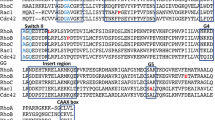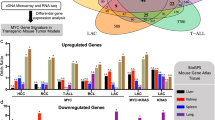Abstract
We have previously described hTDE1, the human homologue of the recently described TDE1/TMS family of proteins whose members have been identified in several species. Although a defined biochemical activity has yet to be assigned to TDE1/TMS family members, previous results point to the overexpression of family members in tumor cell lines or tissues. To define whether hTDE1 may directly impact on neoplastic transformation, we derived and characterized stable Rat-1 transfectants that constitutively express hTDE1 at the plasma membrane. Expression of hTDE1 in Rat-1 transfectants had a significant effect on cell contact inhibition in vitro as judged by a focus formation assay. In addition, by monitoring caspase-3 activity and Hoechst staining, we determined that hTDE1 overexpression partially protects cells from serum starvation- and etoposide-induced apoptosis. Finally, hTDE1 Rat-1-expressing clones accelerated the formation of tumors in a nude mouse assay. Our results suggest that hTDE1 contributes directly to oncogenesis in vivo that may in part be explained by its effect on apoptosis in vitro.
This is a preview of subscription content, access via your institution
Access options
Subscribe to this journal
Receive 50 print issues and online access
$259.00 per year
only $5.18 per issue
Buy this article
- Purchase on Springer Link
- Instant access to full article PDF
Prices may be subject to local taxes which are calculated during checkout





Similar content being viewed by others
References
Aoki S, Su Q, Li H, Nishikawa K, Ayukawa K, Hara Y et al. (2002). J Neurosci 22: 10751–10760.
Bazzoni G, Dejana E . (2004). Physiol Rev 84: 869–901.
Bossolasco M, Lebel M, Lemieux N, Mes-Masson AM . (1999). Mol Carcinogen 26: 189–200.
Chalifour LE, Gomes ML, Wang NS, Mes-Masson AM . (1990). Oncogene 5: 1719–1726.
Chalifour LE, Mes-Masson AM, Gomes ML, Wang NS . (1992). Mol Carcinogen 5: 178–189.
Corn PG, El-Deiry WS . (2002). BioEssays 24: 83–90.
Faust M, Montenarh M . (2000). Cell Tissue Res 301: 329–340.
Ferrigno P, Silver PA . (1999). Methods Cell Biol 58: 107–122.
Grazia Lampugnani M, Zanetti A, Corada M, Takahashi T, Balconi G, Breviario F et al. (2003). J Cell Biol 161: 793–804.
Green DR, Evan GI . (2002). Cancer Cell 1: 19–30.
Grossman TR, Luque JM, Nelson N . (2000). J Exp Biol 203 (Part 3): 447–457.
Inuzuka M, Hayakawa M, Ingi I . (2005). J Biol Chem 280: 35776–35783.
Krueger WH, Gonye GE, Madison DL, Murray KE, Kumar M, Spoerel N et al. (1997). J Neurochem 69: 1343–1355.
Kufe DW, Pollock RE, Weichselbaum RR, Bast Jr RC, Gansler TS, Holland JF et al. (eds). (2003). Cancer Medicine, 6th edn. BC Decker Inc.: Hamilton (Canada).
Lebel M, Mes-Masson AM . (1994). DNA Sequence 5: 31–39.
Nowell PC . (2002). Semin Cancer Biol 12: 261–266.
Ormerod MG, Collins MK, Rodriguez-Tarduchy G, Robertson D . (1992). J Immunol Methods 153: 57–65.
Pearce DA . (2000). J Neurosci Res 59: 19–23.
Player A, Gillespie J, Fujii T, Fukuoka J, Dracheva T, Meerzaman D et al. (2003). Int J Cancer 107: 238–243.
Rassoulzadegan M, Naghashfar Z, Cowie A, Carr A, Grisoni M, Kamen R et al. (1983). Proc Natl Acad Sci USA 80: 4354–4358.
Renan MJ . (1993). Mol Carcinogen 7: 139–146.
Ronot X, Doisy A, Tracqui P . (2000). Cytometry 41: 19–30.
Royle SJ, Murrell-Lagnado RD . (2003). BioEssays 25: 39–46.
Shigeta M, Sanzen N, Ozawa M, Gu J, Hasegawa H, Sekiguchi K . (2003). J Cell Biol 163: 165–176.
Simpson JC, Wellenreuther R, Poustka A, Pepperkok R, Wiemann S . (2000). EMBO Rep 1: 287–292.
Stevens FJ, Argon Y . (1999). Semin Cell Dev Biol 10: 443–454.
Temin HM, Rubin H . (1958). Virology 6: 669–688.
Xu J, Ji C, Wang L, Cao Y, Dai J, Ye X et al. (2003). Mol Biol Rep 30: 47–52.
Acknowledgements
We thank Jason Madore for technical assistance, and Wissal El-Assaad and Abdellah Belmaaza for stimulating discussions. This research was funded in part by a Canadian Institute of Health Research (CIHR) grant and a Cancer Research Society grant to A-MM-M MB has been supported by a CIHR studentship as well as awards from the Canderel and Marc-Bourgie funds of the Institut du cancer de Montréal. FV was the recipient of a Canderel studentship award. A-MM-M is the recipient of a Fonds de la recherche en santé au Québec (FRSQ) Chercheur National Fellowship. RB is the recipient of an FRSQ Senior Fellowship.
Author information
Authors and Affiliations
Corresponding author
Rights and permissions
About this article
Cite this article
Bossolasco, M., Veillette, F., Bertrand, R. et al. Human TDE1, a TDE1/TMS family member, inhibits apoptosis in vitro and stimulates in vivo tumorigenesis. Oncogene 25, 4549–4558 (2006). https://doi.org/10.1038/sj.onc.1209488
Received:
Revised:
Accepted:
Published:
Issue Date:
DOI: https://doi.org/10.1038/sj.onc.1209488
Keywords
This article is cited by
-
Overview of Alternaria alternata Membrane Proteins
Indian Journal of Microbiology (2020)
-
Establishment and characterization of a new feline mammary cancer cell line, FkMTp
Cytotechnology (2016)
-
Changes in the transcriptome of morula-stage bovine embryos caused by heat shock: relationship to developmental acquisition of thermotolerance
Reproductive Biology and Endocrinology (2013)
-
Derivation and characterization of matched cell lines from primary and recurrent serous ovarian cancer
BMC Cancer (2012)
-
Microarray Analysis of Somatostatin Receptor 5‐Regulated Gene Expression Profiles in Murine Pancreas
World Journal of Surgery (2009)



